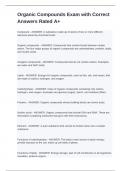-
1. Exam (elaborations) - Organic chemistry - final exam with complete solutions (rated a+)
-
2. Exam (elaborations) - Organic chemistry review exam questions and answers guaranteed pass
-
3. Exam (elaborations) - Organic chemistry – exam with 100% correct answers 2024/2025
-
4. Exam (elaborations) - Organic chemistry exam questions and answers (grade a+)
-
5. Exam (elaborations) - Organic chemistry exam with 100% correct responses
-
6. Exam (elaborations) - Organic chemistry a&p exam questions and answers (rated a+)
-
7. Exam (elaborations) - Organic chemistry: chapters 1, 2, 3 questions with accurate answers
-
8. Exam (elaborations) - Organic chemistry exam questions with 100% correct answers graded a+ latest update!!
-
9. Exam (elaborations) - Organic chemistry -- chapter 5 exam questions with correct solutions 100%
-
10. Exam (elaborations) - Organic chemistry 2 reagents exam questions with guaranteed passing answers
-
11. Exam (elaborations) - Organic chemistry- alkanes exam questions & answers 2024/2025
-
12. Exam (elaborations) - Organic chemistry exam questions & answers graded a+
-
13. Exam (elaborations) - Basic organic chemistry exam questions with accurate solutions rated a+
-
14. Exam (elaborations) - Module 1 - organic chemistry exam questions with accurate solutions 100% correct
-
15. Exam (elaborations) - Families of organic compounds exam questions & answers scored a+
-
16. Exam (elaborations) - Organic chemistry - functional groups exam questions & answers scored a+
-
17. Exam (elaborations) - Organic chemistry
-
18. Exam (elaborations) - Mcat organic chemistry exam questions with 100% accurate answers
-
19. Exam (elaborations) - Isomers: organic chemistry exam questions and accurate responses
-
20. Exam (elaborations) - Lec1: inorganic and organic exam questions and answers rated a+
-
21. Exam (elaborations) - Edexcel organic chemistry a level reactions questions with accurate answers
-
22. Exam (elaborations) - Organic chemistry exam 1 (chapters 1-2) questions with answers rated a+
-
23. Exam (elaborations) - Organic chemistry chapter 1 exam questions with 100% correct answers
-
24. Exam (elaborations) - Organic compounds exam questions with correct answers rated a+
-
25. Exam (elaborations) - Organic chemistry exam questions and accurate answers
-
26. Exam (elaborations) - Organic chemistry chapter 2 exam questions with correct answers
-
27. Exam (elaborations) - Chem honors: organic chemistry exam questions with correct answers
-
28. Exam (elaborations) - Organic chemistry reagents exam questions with correct answers
-
29. Exam (elaborations) - Organic chemistry exam questions with 100% accurate answers
-
30. Exam (elaborations) - Organic chemistry exam questions with accurate solutions scored a+
-
31. Exam (elaborations) - Organic chemistry common pka values exam questions guaranteed pass
-
32. Exam (elaborations) - Organic chemistry - electronic effects top rated exam questions 2024/2025
-
33. Exam (elaborations) - Organic compounds actual exam questions & answers
-
34. Exam (elaborations) - Alcohols - organic chemistry exam questions & answers
-
35. Exam (elaborations) - Aqa a level chemistry- organic chemistry exam questions with 100% verified answers
-
36. Exam (elaborations) - Organic chemistry: alkenes, complete exam with answers guaranteed accurate
-
37. Exam (elaborations) - Aqa as organic chemistry exam questions with expertly crafted answers
-
38. Exam (elaborations) - Ib organic chemistry (hl) questions with top-rated exam answers for high grades
-
39. Exam (elaborations) - Chemistry - 9.1 organic compounds exam questions solved with precision
-
40. Exam (elaborations) - Ncea level 3 - organic chemistry high-quality exam questions with flawless answers
-
41. Exam (elaborations) - Organic chemistry level 2 ncea with expert-approved exam answers with top marks
-
42. Exam (elaborations) - Ib organic chemistry hl and sl accurate exam questions and solutions for top scores
-
43. Exam (elaborations) - Organic chemistry 1 and 2 reactions (verified exam answers with detailed explanations...
-
44. Exam (elaborations) - Inorganic and organic chemistry full exam solutions ensuring top performance
-
45. Exam (elaborations) - Organic chemistry - chapter 1 questions with comprehensive answers for exam success
-
46. Exam (elaborations) - Chemistry a-level (aqa) : 3.1 (introduction to organic chemistry) with perfectly solv...
-
47. Exam (elaborations) - Igcse chemistry: organic chemistry exam questions with 100% accurate solutions
-
48. Exam (elaborations) - Organic chemistry unit grade 12 chemistry (guaranteed correct answers for high-level ...
-
49. Exam (elaborations) - Organic chemistry cie a level (high-scoring exam questions with accurate answers)
-
50. Exam (elaborations) - Organic chemistry 1 final exam questions with guaranteed correct solutions
-
51. Exam (elaborations) - Organic chemistry terms (complete and accurate exam solutions for top grades)
-
52. Exam (elaborations) - Ncea level 2 organic chemistry exam questions solved with precision
-
53. Exam (elaborations) - Ib organic chemistry sl 2 exam answers reviewed and rated for accuracy
-
54. Exam (elaborations) - 10.1 fundamentals of organic chemistry detailed exam solutions verified for accuracy
-
55. Exam (elaborations) - Aqa gcse chemistry - c7 - organic chemistry top-graded exam questions with flawless a...
-
56. Exam (elaborations) - Organic chemistry as level cie, fully answered exam questions for perfect grades
-
57. Exam (elaborations) - Introduction to organic chemistry, accurately solved exam questions with explanations
-
58. Exam (elaborations) - Organic chemistry revision pt1 a+ rated exam questions and answers with guaranteed ac...
-
59. Exam (elaborations) - Understanding organic chemistry, exam solutions with perfect scores guaranteed
-
60. Exam (elaborations) - Organic chemistry basics, correctly answered exam questions for best results
-
61. Exam (elaborations) - Core foundation of organic chemistry, with accurate exam solutions for a+ grades
-
62. Exam (elaborations) - Common organic chemistry terminologies well defined for exam
-
Show more




